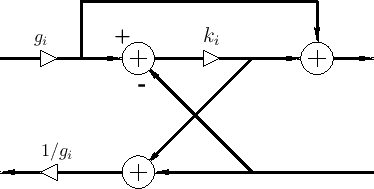
One of the topics in classical network theory is the reflection and transmission, or scattering formulation for lumped networks [35]. Lumped scattering theory also serves as the starting point for deriving wave digital filters (the subject of Appendix F). In this formulation, forces (voltages) and velocities (currents) are replaced by so-called wave variables

where ![]() is an arbitrary reference impedance.
Since the above wave variables have dimensions of force, they
are specifically force waves. The corresponding velocity
waves are
is an arbitrary reference impedance.
Since the above wave variables have dimensions of force, they
are specifically force waves. The corresponding velocity
waves are
![\begin{eqnarray*}
v^{+}(t) &\isdef & \frac{1}{2}[v(t) + f(t)/R_0], \\
v^{-}(t) &\isdef & \frac{1}{2}[v(t) - f(t)/R_0].
\end{eqnarray*}](img3704.png)
Dropping the time argument, since it is always `(t)', we see that